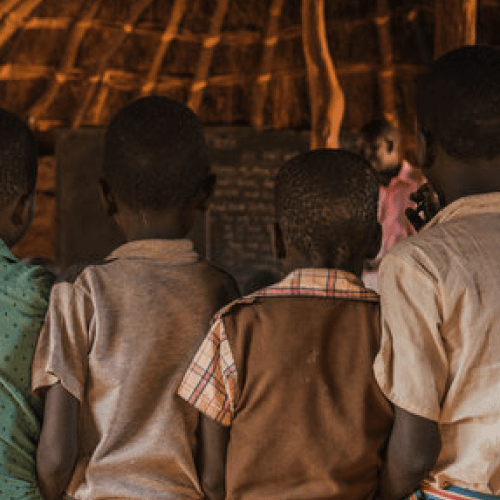Million Children are
Living in Areas of Conflict
Million Young People Living
in Areas of Conflict are Illiterate
Education in conflict – reading the numbers.
The Nuba Mountains region of Sudan, has been in an almost-constant state of conflict since 1989. Due to instability, lack of investment, and even direct attack on schools, many children have not been able to access education. Despite the attacks on schools, children are enrolled at surprisingly high rates. Of the children we survey, 71% of children were attending school, which is higher than the national average.

Click to read more >
1 in 3 children are out of school.

Click to donate >
Support a teacher or a student.

Click to learn more >
Fight for an improved future for the Nuban people.

Click to read more >
Sudan ranks 199 in literacy worldwide.

Our Research in the Nuba Mountains.
Quantitative Research
Qualitative Research
TMM conducted qualitative research with community leaders, parents, teachers, and students. A total of 122 people participated in focus groups and individual interviews. The study helped TMM staff and the local Secretariat of Education understand the peoples' desires regarding education for future generations.
Education in War Zones
Global statistics on education in conflict reflect Sudan's multiple war zones and, more specifically, the Nuba Mountains. Since colonial rule, the conflict has been ongoing, and the compounding lack of access to quality education reignites the fighting due to inequity.
40% of children out of school in Sudan.
Sudan has one of the largest numbers of out-of-school children in the Middle East and North Africa region.
It’s estimated that over three million children in Sudan, aged 5-13 years, are not in the classroom.
From the community.
“Education is like a weapon. It empowers you to fight with words and to stand firm in front of others. It creates opportunities for work so that you won’t depend on anyone. An educated person will be able to face any challenge.” – Mother in the Community
“As a Nuba, we want to promote our culture. Like, agricultural activities, keeping and rearing of animals. Traditional dancing, Nyango. The heritage. We also have wrestling. It is the most important. Sporting—running, skipping. These are things we should not forget.” – Nuba Teacher
2018 youth literacy rates
Quality of education.
Lack of Resources
Sudan ranks 199 in literacy worldwide. The high number of students out of school contributes to high illiteracy rates. The conflicts of Sudan have also lead to a lack of education resources, infrastructure and trained teachers.
Community-Based Systems
To Move Mountains exists to equip students with the knowledge and skills for improved livelihoods, accountable governance, and restored social capital. Through research and community-based design, we are able to tackle these challenges and co-create a culturally appropriate education system that meets the desires of the Nuba people.
Independent Curriculum
Nuba doesn't have its own school curriculum, and has instead adopted those of neighboring countries. For logistical, educational, and cultural reasons, the people of Nuba emphasized a great and urgent need for an independent, contextually relevant curriculum.
The people of Nuba see education as the pathway toward an improved future. They attribute much of their past suffering to war; they describe aerial bombardments on their schools and homes, loss of life and insecurity, and the effects of fighting on schooling, cultivation, and economic development. Yet, with hopes for peace in the region, education is their weapon of choice.
Literacy amoung 8 & 9 year olds.
Through observational research, we experienced rote teaching methods in teacher-centered classrooms. Children struggled to understand literary concepts as they scrambled to write down significant amounts of text.
When conducting quantitative surveys with children 8 and 9 years old, we found that literacy was extremely low. Teachers were eager to teach children that walked many miles to school, but literacy results were meager.
Our data shows a great desire for learning but low quality of education. The motivation of teachers, students and parents provide much potential for improvement.
- The children were only able to identify 4.5 letters out of 10.
- Zero children could identify the sounds of the letters of the alphabet.
- 73% of children surveyed could not read even one word from a list of twenty-one 3 and 4 letter words.
Literacy among 8 & 9 years olds
73% of children surveyed were unable
to read any three and four letter words.
No Data Found
2nd Grade - Reading 3 Letter Words
41% of children that completed 2nd Grade could not read
a single 3 letter word out of 10 words.
No Data Found
Make an impact.
Donate today to change lives
Together we can get started moving mountains and making change.
Children affected by conflict.
Schooling During Conflict
Globally, over 104 million children are living in areas of conflict. One in three of these children are out of school. School dropout rates in conflict areas are also very high. Two in five children living in countries of conflict will never complete primary school. (UNICEF)
High Illiteracy Rate
In addition to access, the quality of education is significantly affected for this population, and the effects are long term. Nearly 59 million young people aged between 15 and 24 years old living in countries affected by conflict or disaster are illiterate, triple the global rate.
Education in War Zones
Global statistics on education in conflict reflect Sudan's multiple war zones and, more specifically, the Nuba Mountains. Since colonial rule, the conflict has been ongoing, and the compounding lack of access to quality education reignites the fighting due to inequity.

